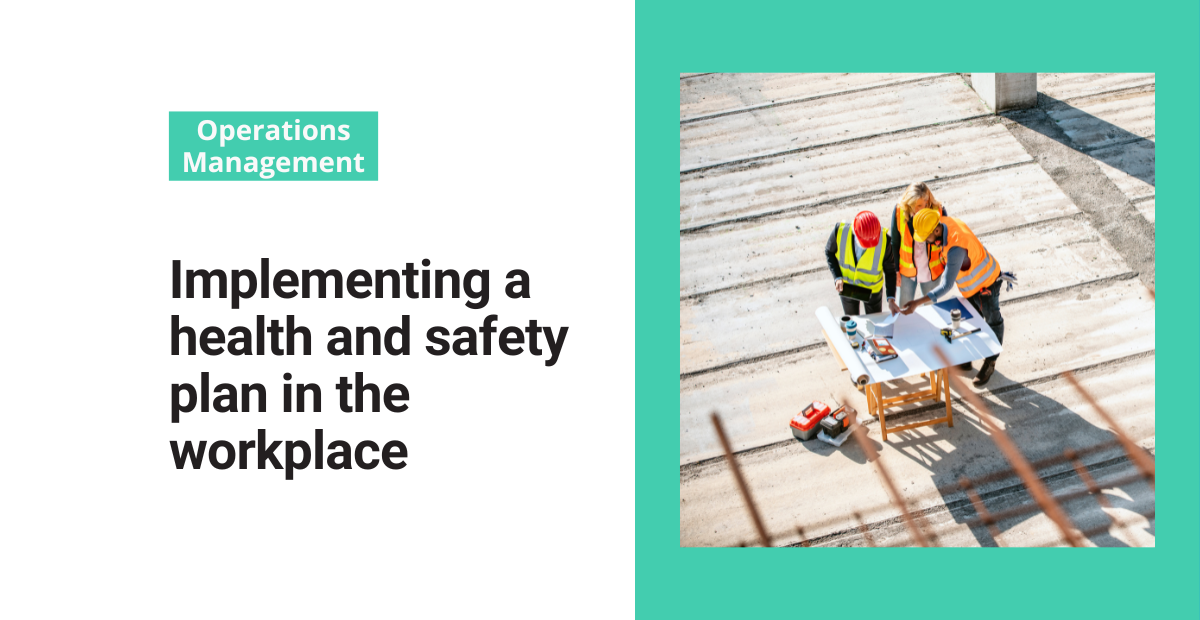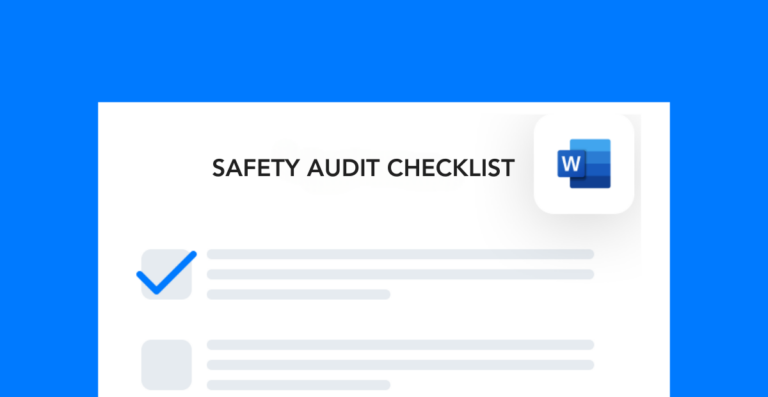Your health and safety action plan will give direction to your entire EHS program. Additionally, it can provide a way to evaluate your site’s performance over time.
Breaking down your program into its components via an action plan helps drive improvement all around. The various parts of your plan should include:
- Management and leadership
- Worker participation
- Hazard identification and assessment
- Hazard prevention and control
- Education and training
- Program evaluation and improvement
- Communication and coordination
Once you’ve outlined your plan, you should tackle each component individually to find areas of improvement.
Free checklist!
Use this safety audit checklist to document workplace hazards and brainstorm corrective actions.
Establishing organizational goals for a health and safety action plan
Health and safety action plans must connect with the organization’s strategic plan for policies, programs, and performance at the corporate level. A written safety plan serves two crucial functions. First, it defines and states formal expectations for management and employee safety performance. In addition, it demonstrates management’s commitment to health and safety.
Before creating and communicating a safety and health plan, the company must lay the groundwork for an effective system.
To begin, write a mission statement that includes the concept of safety. Afterward, document goals that support the vision. Finally, implement strategies and tactics to achieve the objectives. Strategies outline how the organization will accomplish its objectives.
While goals simply state a wish, objectives must include measurable outcomes within a defined period. Therefore, gather information about current workplace conditions. This step helps you select the specific objectives you want to achieve.
Once you set objectives, create detailed plans to ensure the company achieves them.
It’s vital for every company to write a mission statement that demonstrates its commitment to safety while still carrying out the company’s vision. This will show that top management supports the company’s growth through its workers’ health and safety.
Accountability strategy for a health and safety action plan
Next, develop a strategy to create accountability. The strategy will improve performance through measurement and consequences. An effective accountability system first establishes formal standards of behavior and performance. Then it provides the resources needed to meet those standards.
Physical resources include equipment and materials, while non-physical resources include education and training. Next, there needs to be an effective system of measurement used to provide feedback to employees. There should also be appropriate application of practical consequences. Appropriate means that consequences are justified and consistently applied to correct behaviors.
Lastly, there must be a continual evaluation of the accountability system. The evaluation could involve an analysis headed up by a safety committee or the safety coordinator. Improvements should be headed up by management.
Involving everyone in the planning process
When everyone gets involved, a safety plan succeeds. Moreover, when employees understand their role in the plan, leaders can manage and communicate it more effectively. Therefore, management must communicate safety and health policies to employees. They must also be supported by employees.
It is crucial to clearly define mandatory and discretionary involvement to increase ownership, empowerment, and create opportunities for safety leadership. Examples of mandatory involvement include inspecting and reporting unsafe conditions.
Discretionary involvement could include submitting safety suggestions to the safety committee or becoming a safety committee member.
Another critical factor is that adequate resources, such as personnel, methods, equipment, and funds, are available to all personnel to meet responsibilities.
Necessary resources should be exclusively within the control of the individual holding the responsibility. Also, all personnel should be able to apply resources in order to meet responsibilities effectively.
Training and nurturing workers
Establishing a training program for continuous education in health and safety can help to improve the skills and knowledge of everyone involved.
The training must state its purpose, outline the topics, and identify who will conduct it. In addition, the company must provide training during new-hire orientation, on the job, before the start of a shift, or whenever a new hazard arises.
Assessment and analysis
Corporate leaders should conduct employee surveys to learn how workers perceive the organization’s health and safety culture. The survey results may reveal weaknesses in the current system, and management should discuss these findings directly with employees.
In addition, management must report injury and illness data analyses to employees. They must also communicate hazard control procedures to anyone who may be affected.
An effective and anonymous hazard reporting system should serve as a core part of hazard identification. Moreover, management must perform job hazard analyses whenever needed. Finally, leaders must conduct change analyses whenever facilities, equipment, materials, or processes change.
Evaluation and improvement for health and safety action plan
Conducting a gap analysis is a great way to determine the program’s current state versus how far the program needs to go to improve. Similarly, your plan should ensure that all incidents undergo investigation and root cause analysis.
The PDCA cycle is another tool you can use for implementing change to prevent incidents. If the changes made are ineffective and not working as intended, those changes should be adjusted with the new knowledge gained.
You could conduct a review of your health and safety action plan at least once per year. A review ensures that the plan is evolving satisfactorily and that continuous improvements are occurring.




